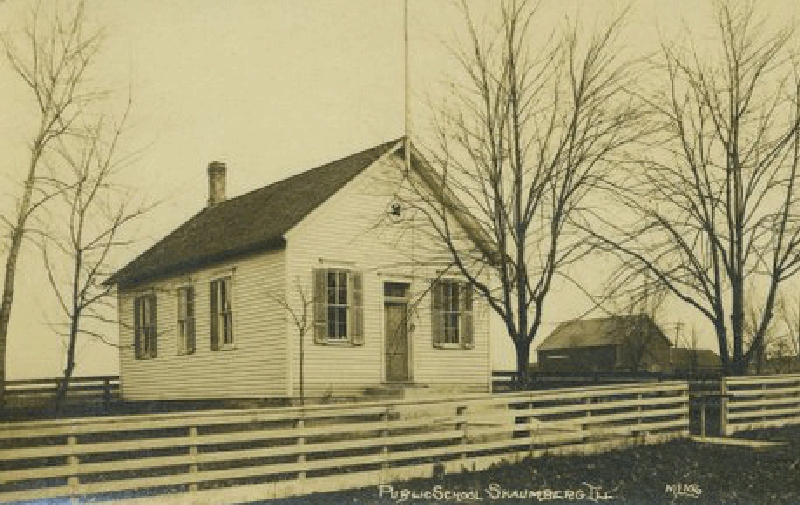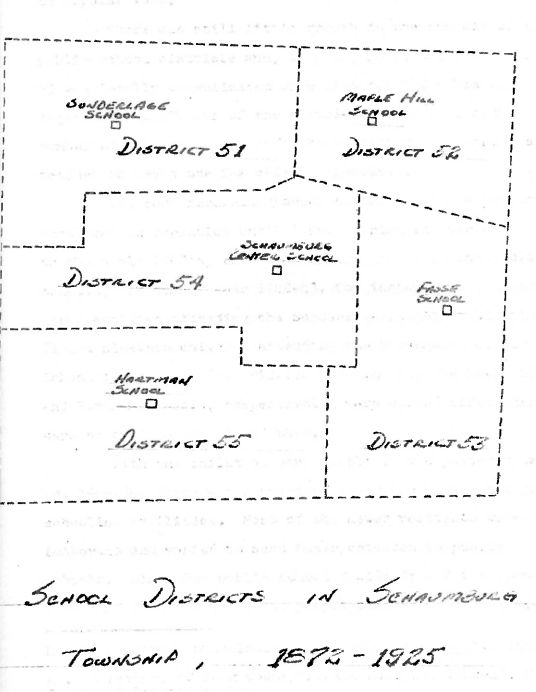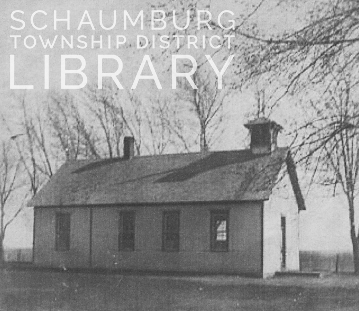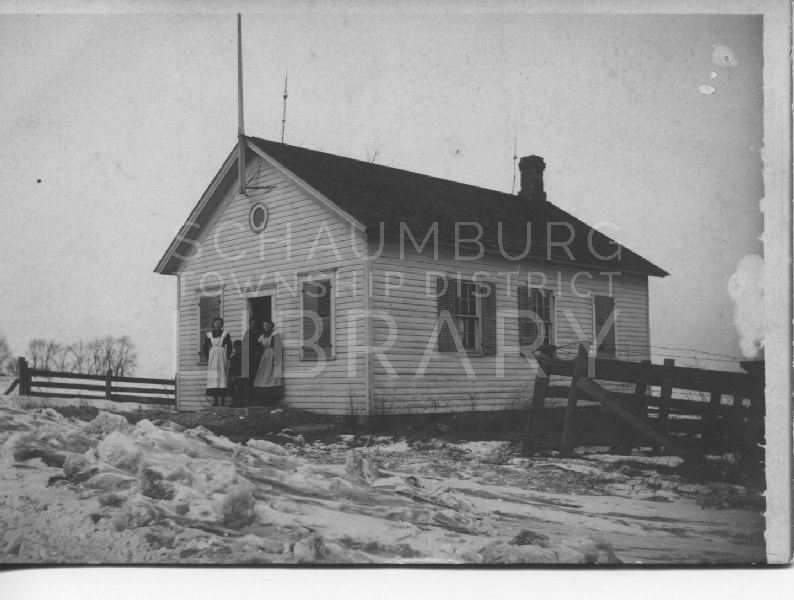If we go back to the very earliest days of the township, two names that pop up time and again are Schierding and Schween. These families were some of our earliest residents and were interconnected through a marriage that occurred around 1840 in Chicago.
The tale of how the families met is told in this marvelous account by Clara (Schween) Kaste. She was the granddaughter of Ernest Philip and Mary (Schierding) Schween. (We see the Schween name often popping up as “Swain” in many documents.
Ernest came to this country with his brothers, William and Augustus. They all purchased land patents in Schaumburg Township from the federal government. Ernest purchased his four parcels in Section 22 in 1845 and 1848. Augustus also purchased two parcels in Section 22 in 1846. William purchased two parcels in Section 5 in 1848, and one parcel in Section 8 in 1849.
There is an excellent account of William Schween–and his brothers–on Find A Grave that is taken from History of Cook County, Illinois: From the earliest period to the present time by A. T. Andreas, Publisher, Chicago 1884.
Ernest and Mary had five children who were all born in either Chicago or Schaumburg Township, per their family tree in Family Search, the 1850 U.S. Federal Census and the Chicago Tribune: Catherine b. 1841, Helene b. 1847, William b. 1849, Henry b. 1850, August b. 1854.

Clara (Schween) Kaste, who wrote this account, was one of two children of August, the youngest son, and his wife, Dorothea (Koelle.) Clara was born on June 17, 1884. Her brother, Walter was born in 1887.
We have to assume that they were born in Schaumburg Township because, according to the 1886 Cook County plat map created by L.M. Snyder & Co., August owned the same E.P. Swain property on the southwest corner of Schaumburg and Roselle Road, as noted in the earlier map below.

The following account was written by our Mother, Clara (Schween) Kaste, wife of William Kaste, before her death in 1956.
AS TOLD TO ME BY GRANDMOTHER SCHWEEN – Mrs. Ernest Schween (Mary Schierding)
On the 16th of October 1810 in Fursternau, Hanover, a little boy opened his eyes to this world. (Ernest Phillip Schween). Just ten years after this date a little girl was born at Osnabruck, Hanover. (Mrs. Ernest Schween, nee Mary Schierding).

The little girl grew up in this community, her father following his profession or whatever you call it – a tailor. This was considered the ordinary working class, but below land owner. A little brother joined the family group, who afterward was known as Henry Schierding, Esq of Palatine.
In 1838 this little family joined other relatives and came to Chicago, Illinois which, at that time, wasn’t much more than a good-sized village, and swampy at that. They bought two acres of land on Clark Street, north of the Chicago River.
In the meantime, the little boy that had seen the light of day (Ernest Schween) at Furstenau Hanover, grew up to be a young man taking the trade up as a coppersmith and as the future looked brighter in America he, with two brothers, came to Buffalo, New York, either in the year 1835 or 36.
After staying in Buffalo two years, he decided to go to Chicago and, looking up some people of German descent, he met a girl on Clark Street and, after a short courtship, married her. And that was Ernest Phillip Schween and Mary Schierding who, afterwards, were called grandparents to this writer.

After this wedding, the young couple, with the Schierding family, decided to sell their two acres, being too swampy in Chicago, and join relatives that had settled at Schaumburg, Illinois. But at that time [it] was known as Wildcat’s Grove but when they got there no more land was available.
So they went a few miles further south and located at Sarah’s Grove and took up two hundred and fourteen acres of land–part of this was wooded. This was afterwards known as the Schween place (pronounced Swain). (Note: transcriber suspects that this was 160 acres, first purchased in January 4, 1843)

For this land they had to pay the government $1.25 an acre but, not having this much money, my grandfather and his brother-in-law came back to Chicago and procured work helping dig the new Ottawa-Michigan Canal, earning $1.25 each day (man and team).
In the meantime, my grandmother, with her father, Phillip Schierding and her mother, Katrina nee Ottman, stayed at the farm trying to get a start at farming the Illinois prairie.
But, while the young men were away at their work, the mother suddenly took sick with severe cramps and after three days of suffering without doctor there, had went to sleep to wake no more. So, with the help of relatives from Wildcat’s Grove, they selected a high spot on the south side of the woods and there they laid her to rest (Mrs. Philip Schierding, nee Katrina Ottman).
So, when the young men got word what had happened – it took three days to make the trip with an ox team – they hastened home, but no mother anymore. This was one of the hardships of the early settlers.
But it was not all hardships. One day Grandpa Schierding found some little kittens, pretty black and white, [in the] back of a hay shed and putting them in his cap, took them to the house in a happy mood, but soon a peculiar odor was noticed and as you can guess they were little skunks. These little kittens lost their happy home.
Another time a deer came along with the cow to the hay shed.
Gradually, a few more settlers came and a minister from Addison – then called Dunkley’s Grove – began to look up the German speaking people and tried to have church services. The most suitable place selected was Grandfather’s barn – so services were held in the barn and the rooster crowing outside. And, thru God’s grace, this was the beginning of the Schaumburg Congregation (St. Peter Lutheran Church).

The missionary that started this work was Francis Hoffman–afterwards quitting this work–he went to Milwaukee, going under the pen name of Hans Buschbauer, writing for the Deutsch Wort and Erholungsunden.
Here I cannot help to add that when the weather was nice in spring, that a rattlesnake would hang itself on the edge of the roof trying to sun itself. Although these snakes weren’t plentiful, still, a Mrs. Gieseke, while chasing a pig in the prairie grass, was bitten and died there [from the bite.] She was buried in the Schween Woods cemetery.
Gradually, more settlers began to come in and it was at this time my mother’s parents, Henry Koelle and Christina, nee Senne, first came to Schaumburg township near Elk Grove and this must have been about in the early 50’s (1850’s). But, before going further, I must add the story of their romance.
On account of Grandpa [Koelle] being the only son, he was to inherit the family estate. Although burdened with debt, [he] was supposed to marry a wealthy girl, but he fell in love with Christina Senne, also of a well to do family but, as was customary at that time in that part of Germany, [she] would only get a dowry as she was not the eldest one in the family.
As soon as Christine found out she was not considered welcome in the Koelle family, she secretly made plans to go along with a sister and half-brother, Henry von Harz (the von name was dropped by the children but the father would not give up the “von” name under any consideration) to America. But, just as soon as Grandpa found out she had left, he dropped everything and followed his sweetheart to America.
They were married soon afterward and settled in Palatine Township where Grandpa, with several relatives and friends, built the Plum Grove Evangelical Church. He always tried to help maintain this church as much as he was able to, and sometimes more. As Grandpa was a religious man, grace was said before each meal and, whenever possible, he read his Bible daily.
My mother was a third child of this union, born April 8th, 1860, christened soon afterward and given the name of Dorothea but, generally, called Doretta. She had two sisters, Caroline and Fredericka, older than herself. Fredericka died when she was twelve years old and, as Caroline grew up a cripple, my mother was considered more as the oldest child; hence, burdens and confidences fell on her young shoulders more than on her two older sisters.
Starting school, as we lived in a community of German speaking people, the English School was looked on as a necessary thing to be allowed, but the children were mostly sent to the German Lutheran Parochial school. Although I do not like to write this about my old hometown still, it really happened, and when the English school enrollment got so low, there were rumors of closing it.

My father’s father (Ernest Schween) had given the piece of ground the school was on. [The] land [was] to be used only for school purposes [and seeing the wisdom of having a public school], my father did not want the school closed.
Two other neighbors, Mr. Fenz and Mr. Sporleder did not want it closed either so, as to keep the school open, I was sent to school [as a] four and a half year old, with Mr. Fenz’s oldest son, Herman, and Mr. Sporleder’s youngest daughter, Emily, and Emily Pelletier and myself. The school stayed and is still there on the same spot after all these years and much more appreciated.
The Result of Being Disobedient
Our nearest neighbor had a girl by the name of Martha (?) who used to give rides in a little express wagon. On this occasion I had asked my mother if I could go over to Martha’s house and she said “No” but I couldn’t see the reason why I couldn’t go so I just slowly left the house and wandered over to Martha’s.
All at once I realized it was time to go home and, with a guilty conscience, looked for Grandma. I found her home alone and my prettiest blue lawn dress laid out for me to wear. I asked Grandma why my dress was there and where was my mother? She answered me saying “Why did you run away? Your father and mother went to Grandpa and Grandma Koelle’s (and how I loved these two people) and they wanted to take you along but you ran away. That’s why your mother said you couldn’t or shouldn’t go to Martha’s.”
I went out of that house and had a good cry but this was not the end yet. When mother came home she asked if I’d come along with her to do a little chore and I thought everything is alright now. But, I was mistaken as what I did get was a spanking and had to promise my mother never to run away again. And, that cured me from running away from home to Martha’s without permission.
First Recollections
Opening my eyes wondering where I was, I found myself in the old cradle which was [un]usually large – parked in the living room. Before I realized what woke me, I heard my father coming in the door and, after speaking a few words to my mother, also to Grandma – my father’s mother (Mary Schierding), he came over to me and said “And what do you think I brought for you?” And there he had a picture book with a big white and tan cat on the front cover. The cat had a red ribbon with a big red bow around its neck. On the inside of the book was the alphabet–first the capital letters and then the small letters. Each letter was in a square by itself and alternating in the colors of black and red.
My father gave me this book and showed me the letters and that was the start of my learning ABC’s. Father had been on jury duty in Chicago and he had brought me this book as a Christmas gift. [To be continued]
Next week this account, written by Clara (Schween) Kaste, will focus on how German weddings were celebrated around the turn of the twentieth century.
In the meantime, let’s wrap up the history of Clara’s family in Schaumburg Township.

Ernest Schween died on January 2, 1875 in Schaumburg Township. Mary followed him on June 17, 1909. To the best of our knowledge, they were buried in the cemetery on their property, a remnant that can now be found on Cedarcrest Drive in Schaumburg. It is in the Timbercrest subdivision. This area, along with The Woods subdivision, was frequently referred to as Schween’s Grove.

August, the father of Clara (Schween) Kaste died on August 1, 1911. His wife, Dorothea, predeceased him on July 4, 1900. It is likely they both died in Schaumburg Township given the fact that both of them are buried in St. Peter Lutheran Church cemetery in Schaumburg Township.
Clara, the author of this document, died on September 16, 1956, having lived in Lockport, Illinois with her husband, William Kaste. He died one year later on November 2, 1957. They are both buried in Bethania Cemetery in Justice, Illinois.
We can thank Clara for taking the time to record the account of the Schweens and Schierdings in Schaumburg Township. It is a priceless document of our local history.
Jane Rozek
Local History Librarian
Schaumburg Township District Library
jrozek@stdl.org









































